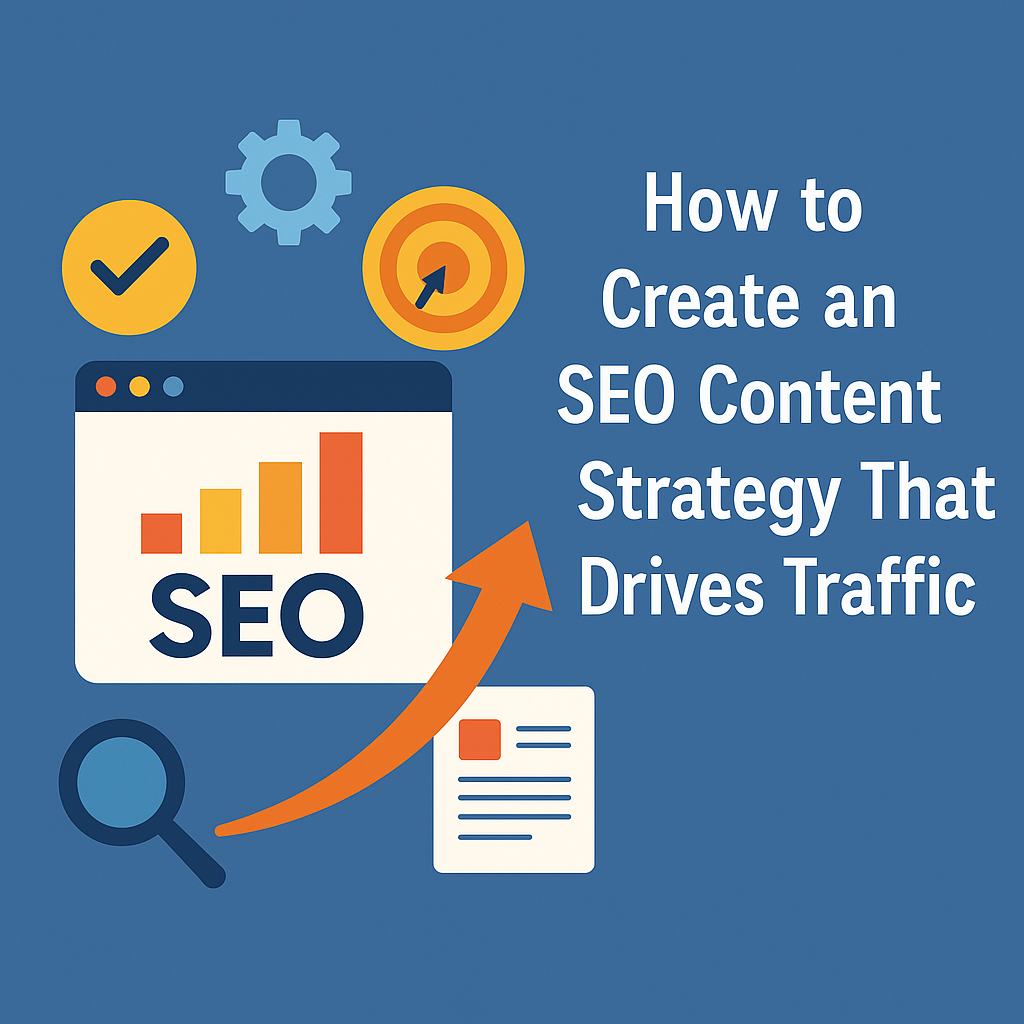Creating an effective SEO content strategy is essential for any business looking to boost its online presence. With so many companies vying for attention in the digital space, having a well-thought-out plan can set you apart from the competition. In this article, we’ll walk through the process of crafting an SEO content strategy that improves your search rankings and drives consistent traffic to your site. For further insights and bespoke guidance, please visit our homepage or contact us via our contact page.
Understanding the Role of SEO in Content Strategy
Content marketing and SEO fusion is at the heart of a robust digital marketing strategy. SEO (Search Engine Optimisation) ensures your content is discoverable by search engines, while content marketing engages and educates your audience. When these two components work together, your website can achieve higher rankings, enhanced credibility, and steady organic traffic.
Over the years, I’ve seen how businesses that invest in a strategic approach to content creation benefit from improved search visibility and deeper connections with their audience. The key is to develop valuable and optimised content for search engines, ensuring that every piece of content serves a dual purpose: to inform your readers and rank well.
Laying the Foundation for Your SEO Content Strategy
Before you begin producing content, it’s essential to lay a strong foundation by understanding your audience, defining your goals, and analysing your current online presence. This preparation sets the stage for a targeted and effective strategy.
Identifying Your Target Audience
Begin by asking yourself:
- Who is my ideal customer?
- What are their pain points and needs?
- How do they search for solutions online?
Gathering insights through surveys, social media interactions, and analytics can help you create detailed buyer personas. These personas will guide the tone, style, and content topics that resonate with your audience.
Setting Clear Objectives
Clear, measurable objectives drive a successful SEO content strategy. These might include:
- Increasing organic traffic by a certain percentage
- Generating more leads or conversions
- Enhancing user engagement on your website
Establishing SMART (Specific, Measurable, Achievable, Relevant, Time-bound) goals ensures that your strategy remains focused and you can track your progress effectively.
Auditing Your Existing Content
Evaluate your current content to identify what’s working and what isn’t. Ask yourself:
- Which pieces are driving the most traffic and engagement?
- Are there gaps in your content that your competitors are addressing?
- How well does your content align with your brand’s voice and SEO goals?
This audit provides valuable insights into how you can refine your strategy and build on your strengths.
Conducting Thorough Keyword Research
Keyword research is at the core of any SEO content strategy. By understanding your target audience’s terms, you can create content that meets their needs and ranks well on search engines.
Short-Tailed vs Long-Tailed Keywords
Short-tailed keywords, such as “SEO” and “Content Strategy,” are broad terms with high search volumes but often intense competition. In contrast, long-tailed keywords are more specific phrases that may have lower search volumes but tend to attract a highly targeted audience. Balancing both types of keywords can enhance your strategy.
Using the Right Tools
Utilise keyword research tools such as Google Keyword Planner, SEMrush, or Ahrefs to uncover valuable insights. These tools help you identify:
- Search volume and competition levels
- Related keywords and phrases
- Trends over time
By compiling a comprehensive list of keywords, you can map them to different stages of your content strategy.
Creating a Keyword Map
Organise your keywords by clustering them into relevant topics. This approach helps you structure your content around specific themes, making it easier to create focused articles, blog posts, or landing pages that address different aspects of your audience’s queries.
Developing a Content Calendar
A content calendar is a powerful tool for organising and tracking your SEO content strategy. It ensures a consistent flow of content that aligns with your business goals and seasonal trends.
Planning Your Content Topics
Based on your keyword research and audience insights, brainstorm a list of relevant and engaging topics. Consider content formats such as:
- How-to guides
- Listicles
- Case studies
- Industry news and insights
- Opinion pieces
Mapping these topics to specific dates in your calendar ensures you cover various subjects throughout the year.
Balancing Evergreen and Trending Content
Evergreen content remains relevant over time, while trending topics can drive traffic bursts. An effective strategy includes both:
- Evergreen Content: These pieces address long-standing questions or challenges and are updated periodically.
- Trending Content: Timely articles or posts that capture current events, industry news, or emerging trends.
Scheduling and Consistency
Consistency is key. Decide on a manageable posting schedule and stick to it. Whether you publish weekly or biweekly, regular updates signal to search engines and readers that your site is active and up-to-date.
Crafting High-Quality, Optimised Content
With a solid plan in place, the next step is to produce high-quality content that is also optimised for search engines. This involves blending creativity with technical SEO best practices.
Writing for Your Audience
Your content should be engaging, informative, and tailored to your audience. Here are some tips:
- Conversational Tone: Write as if speaking directly to a friend or colleague.
- Relatable Scenarios: Use anecdotes or case studies that illustrate your points.
- Clear and Concise: Avoid overly technical language unless it’s necessary, and break up large chunks of text with subheadings and bullet points.
SEO Optimisation Techniques
Integrate SEO best practices throughout your content:
- Title and Meta Descriptions: Craft compelling titles and meta descriptions that include your primary keywords.
- Header Tags: Use varied styles to structure your content and guide readers through your article.
- Internal Linking: Link to other relevant pages on your website to improve navigation and boost SEO. For instance, linking to your homepage and contact page can help spread link equity.
- Keyword Placement: Naturally incorporate your targeted keywords in the title, headers, and body text without overstuffing.
- Multimedia Elements: Include images, infographics, or videos to enhance the reader’s experience and reduce bounce rates.
Optimising for User Experience
A seamless user experience is crucial not just for retaining visitors but also for SEO:
- Readability: Use short paragraphs, varied sentence structures, and clear subheadings.
- Mobile Optimisation: Ensure your website is fully responsive and loads quickly on all devices.
- Call-to-Action (CTA): Include strategic CTAs to guide your readers towards the next step, whether it’s subscribing to your newsletter or exploring your services.
Promoting Your Content Effectively
Creating great content is only half the battle. Promoting it is essential to drive traffic and enhance your SEO performance.
Leveraging Social Media
Social media platforms are excellent channels for content distribution:
- Share Regularly: Post your articles on LinkedIn, Twitter, and Facebook platforms.
- Engage with Followers: Respond to comments and encourage discussion to foster a community around your content.
- Utilise Hashtags: Use relevant hashtags to increase the visibility of your posts.
Email Marketing
Email newsletters are a powerful tool for driving traffic:
- Build a Subscriber List: Encourage visitors to subscribe for updates.
- Personalised Content: Tailor your newsletters to include content that appeals to different segments of your audience.
- Regular Updates: Send out periodic newsletters highlighting your latest articles and insights.
Collaborating with Influencers
Influencer marketing isn’t just for social media—it can also boost your content’s reach:
- Guest Posts: Contribute articles to reputable industry blogs.
- Interviews and Collaborations: Partner with influencers to create content that benefits both parties.
- Link Building: Influencers can help build quality backlinks by sharing your content with their audience.
Repurposing Content
Maximise the value of your content by repurposing it into different formats:
- Infographics: Convert data and insights into visually appealing infographics.
- Podcasts and Videos: Adapt your articles into podcasts or video scripts.
- E-books: Combine several articles into a comprehensive e-book that you can offer as a free download.
Monitoring, Analysing, and Refining Your Strategy
An effective SEO content strategy is dynamic. Regularly monitoring your performance and refining your approach ensures ongoing success.
Tracking Key Metrics
Use analytics tools such as Google Analytics and Search Console to monitor:
- Organic Traffic: Track how many visitors arrive via search engines.
- Bounce Rate: Understand whether visitors find your content engaging enough to stay.
- Conversion Rates: Measure how well your content converts visitors into leads or customers.
- Keyword Rankings: Monitor your search rankings to see if your efforts are paying off.
Adjusting Your Strategy Based on Data
If certain pieces of content aren’t performing as expected, consider updating them with fresh information, new keywords, or enhanced visuals. An iterative approach to content optimisation can lead to significant improvements over time.
Seeking Feedback
Don’t hesitate to ask your audience for feedback. Surveys, social media interactions, or direct comments on your blog can provide insights into what is working and where improvements are needed. This feedback loop is invaluable in refining your overall strategy.
Real-Life Anecdotes and Success Stories
I remember working with a mid-sized business that struggled to gain traction online. Their informative content lacked the SEO focus necessary to reach a wider audience. After we restructured its content strategy—conducting thorough keyword research, establishing a detailed content calendar, and implementing rigorous SEO best practices—its organic traffic increased dramatically. Not only did this boost their search engine rankings, but it also led to a noticeable increase in customer engagement and conversions.
Another memorable case involved a start-up that was just entering the market. By developing a content strategy that included guest posts, social media promotions, and regular blog updates, we managed to position them as thought leaders in their industry. This holistic approach attracted visitors and built a loyal audience over time.
Tips and Best Practices for Long-Term Success
Stay Updated with Industry Trends
The world of SEO and content marketing is ever-changing. Subscribing to industry newsletters, following reputable SEO blogs, and attending webinars can help you stay informed about the latest trends and algorithm updates.
Invest in Quality Over Quantity
Churning out large volumes of content is tempting, but quality should always come first. High-quality, well-researched content will attract backlinks, social shares, and repeat visitors.
Foster a Collaborative Environment
Encourage collaboration within your team. Whether it’s brainstorming new content ideas or refining existing pieces, a collaborative approach often yields richer and more diverse content.
Experiment and Innovate
Don’t be afraid to try new formats or ideas. Testing different content formats—be it interactive tools, video series, or podcasts—can reveal new ways to engage your audience and drive traffic.
Balance SEO and Creativity
While technical SEO is crucial, remember that creativity truly engages readers. Aim for a balance between content that is optimised for search engines and enjoyable to read.
Future-Proofing Your SEO Content Strategy
As technology and search engine algorithms continue to evolve, it’s important to future-proof your content strategy:
- Embrace New Technologies: Monitor emerging trends such as voice search optimisation, AI-driven content tools, and interactive multimedia.
- Adapt Your Approach: Be willing to pivot your strategy based on analytics, industry changes, and audience feedback.
- Continuous Learning: Invest time in training and development for your team. Staying ahead of industry trends ensures your content remains relevant and competitive.
Conclusion: Driving Traffic with a Strategic Approach
Creating an SEO content strategy that drives traffic is a multifaceted endeavour. It requires a deep understanding of your audience, meticulous planning, high-quality content production, and ongoing optimisation. By integrating keyword research, a well-structured content calendar, and effective promotion tactics, you set the stage for long-term digital success.
Remember, this is a journey. Continuous learning, regular updates, and a willingness to adapt are the keys to maintaining a vibrant online presence that attracts visitors and converts them into loyal customers.


